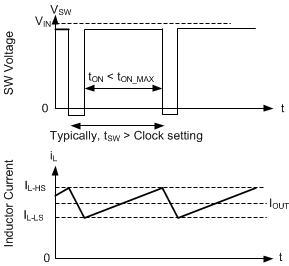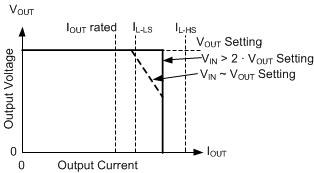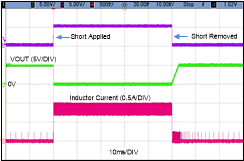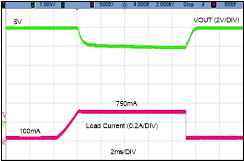SNVSB91C July 2019 – June 2020 LMR36506-Q1
PRODUCTION DATA.
- 1 Features
- 2 Applications
- 3 Description
- 4 Revision History
- 5 Device Comparison Table
- 6 Pin Configuration and Functions
- 7 Specifications
-
8 Detailed Description
- 8.1 Overview
- 8.2 Functional Block Diagram
- 8.3
Feature Description
- 8.3.1 Enable, Start-up and Shutdown
- 8.3.2 External CLK SYNC (with MODE/SYNC)
- 8.3.3 Adjustable Switching Frequency (with RT)
- 8.3.4 Power-Good Output Operation
- 8.3.5 Internal LDO, VCC UVLO, and VOUT/BIAS Input
- 8.3.6 Bootstrap Voltage and VCBOOT-UVLO (CBOOT Terminal)
- 8.3.7 Output Voltage Selection
- 8.3.8 Spread Spectrum
- 8.3.9 Soft Start and Recovery from Dropout
- 8.3.10 Current Limit and Short Circuit
- 8.3.11 Thermal Shutdown
- 8.3.12 Input Supply Current
- 8.4 Device Functional Modes
-
9 Application and Implementation
- 9.1 Application Information
- 9.2
Typical Application
- 9.2.1 Design Requirements
- 9.2.2 Detailed Design Procedure
- 9.2.3 Application Curves
- 9.3 What to Do and What Not to Do
- 10Power Supply Recommendations
- 11Layout
- 12Device and Documentation Support
- 13Mechanical, Packaging, and Orderable Information
Package Options
Mechanical Data (Package|Pins)
- RPE|9
Thermal pad, mechanical data (Package|Pins)
- RPE|9
Orderable Information
8.3.10 Current Limit and Short Circuit
The LMR36506-Q1 is protected from overcurrent conditions by cycle-by-cycle current limiting on both high-side and low-side MOSFETs.
High-side MOSFET overcurrent protection is implemented by the typical peak-current mode control scheme. The HS switch current is sensed when the HS is turned on after a short blanking time. The HS switch current is compared to either the minimum of a fixed current set point or the output of the internal error amplifier loop minus the slope compensation every switching cycle. Since the output of the internal error amplifier loop has a maximum value and slope compensation increases with duty cycle, HS current limit decreases with increased duty factor if duty factor is typically above 35%.
When the LS switch is turned on, the current going through it is also sensed and monitored. Like the high-side device, the low-side device has a turnoff commanded by the internal error amplifier loop. In the case of the low-side device, turnoff is prevented if the current exceeds this value, even if the oscillator normally starts a new switching cycle. Also like the high-side device, there is a limit on how high the turnoff current is allowed to be. This is called the low-side current limit, ILS-LIMIT (or IL-LS in Figure 19). If the LS current limit is exceeded, the LS MOSFET stays on and the HS switch is not to be turned on. The LS switch is turned off once the LS current falls below this limit and the HS switch is turned on again as long as at least one clock period has passed since the last time the HS device has turned on.
 Figure 19. Current Limit Waveforms
Figure 19. Current Limit Waveforms Since the current waveform assumes values between ISC (or IL-HS in Figure 19) and ILS-LIMIT, the maximum output current is very close to the average of these two values unless duty factor is very high. Once operating in current limit, hysteretic control is used and current does not increase as output voltage approaches zero.
If duty factor is very high, current ripple must be very low in order to prevent instability. Since current ripple is low, the part is able to deliver full current. The current delivered is very close to ILS-LIMIT.
 Figure 20. Output Voltage versus Output Current
Figure 20. Output Voltage versus Output Current Under most conditions, current is limited to the average of IL-HS and IL-LS, which is approximately 1.3 times the maximum-rated current. If input voltage is low, current can be limited to approximately IL-LS. Also note that the maximum output current does not exceed the average of IL-HS and IL-LS. Once the overload is removed, the part recovers as though in soft start.
 Figure 21. Short Circuit Waveform
Figure 21. Short Circuit Waveform  Figure 22. Overload Output Recovery (100 mA to 750 mA)
Figure 22. Overload Output Recovery (100 mA to 750 mA)